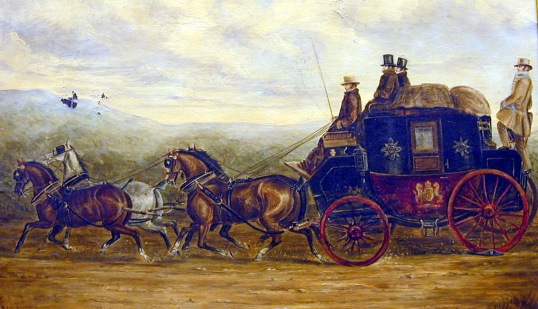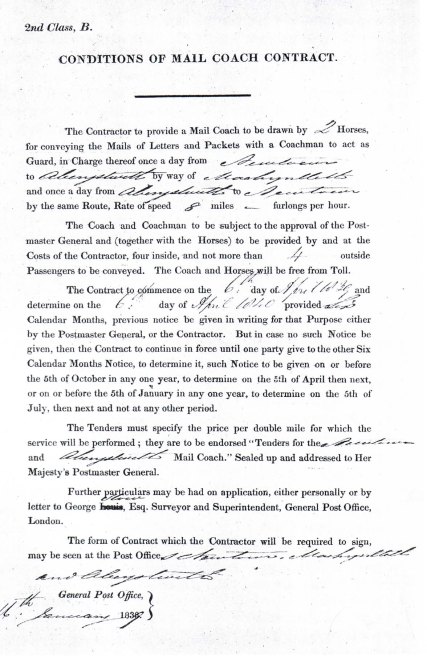Other types of travel The Gloucester-Aberystwyth Mail Coach (in the manner of Charles Cooper Henderson.)
The Gloucester-Aberystwyth Mail Coach (in the manner of Charles Cooper Henderson.)
 Requests for tenders for a Mail coach service to be drawn by 2 horses for a year from 6th April, 1839. The successful contractor to travel from Newtown to Aberystwyth via Machynlleth and back each day, [a total of 90 miles], at a rate of 8 m.p.h. with a maximum of 8 passengers, 4 inside, 4 out. This required two six hour journeys, with the probability of changes of horses at more than one place along the route.
Requests for tenders for a Mail coach service to be drawn by 2 horses for a year from 6th April, 1839. The successful contractor to travel from Newtown to Aberystwyth via Machynlleth and back each day, [a total of 90 miles], at a rate of 8 m.p.h. with a maximum of 8 passengers, 4 inside, 4 out. This required two six hour journeys, with the probability of changes of horses at more than one place along the route.
Mail coaches were more expensive than stage coaches but were quicker and more reliable. The charge during the first half of the 19th century was about double that of a stage coach (i.e. about 6d per mile) plus tips to the driver and guard and baggage was extra.
The first mail coach routes were established by 1784. By the following year there was a regular service on the important route to Ireland, from London to Holyhead. Mail coaches began to disappear as soon as the main-line railways in Wales were well-established by the 1850s and it is said that the last time a mail coach ran in Britain was in 1874.
Long mail coaches journeys normally stopped only to change the horses, or to enable the driver and passengers to have a refreshments. They would otherwise run day and night.
As Catherine Hutton recorded in 1797 (below), meals were ready for the driver and passengers when the coach arrived at an inn, but in order to keep to the timetable, coaches were supposed to leave an inn on time, even if they arrived late, thus presenting a few passengers with the experience of sitting down to a ready meal but unable to finish it because the coach was due to leave.
Tourists occasionally took a mail coach from one inn or town to the next. Initially, mail coaches were allowed to carry four passengers inside and one next to the driver. Later, an additional couple were allowed to sit behind the driver. This small number of passengers caused problems, for although the coaches were regular, there was no guarantee that there would be a space on the next and there might not be another for at least 24 hours. In addition, for those travelling outside, the views might have been better but they would have been subject to whatever the weather was, day and night.
The average speed of the coaches was usually 7-8 mph in summer and about 5 mph in winter but by the mid 1830s the average summer speed had risen to 10 mph. In 1797 Catherine Hutton (below) reported that the London to Holyhead mail took 48 hours to travel 282 miles – an average of 5.8 mph including stops.
1797
I look with admiration on the mechanism of the mail-coaches. Not on the construction of their wheels and springs, though the motion produced by these is as easy as anything, except sailing, but on the whole, considered as one grand machine, pervading every part of the kingdom, and governed by invariable laws. As an individual, I never tried them but once. I was then struck with the singularity of finding the horses or the dinner waiting our arrival at the different inns, according as we were to proceed, or refresh ourselves, instead of having them to bespeak. It reminded me of those scenes of enchantment, where the castle door stands open, and the table is spread, before the stranger has even time to signify his wishes. I own I was also struck with another circumstance – as decent people do, sometimes, travel in stage-coaches; and as all, probably, pay for what they eat and drink, I was surprised that they should be regarded, at inns, as vagrants, who were whipped from town to town.
The Holyhead mail-coach leaves London at seven o clock in the evening, and reaches Holyhead about the same hour next morning but one; performing a journey of two hundred and eighty two miles in forty-eight hours. The fare is five guineas each person for the whole way, or sixpence per mile for any part. Each passenger pays a shilling at Conwy ferry, and the same at Bangor ferry.
Letters from North Wales Written by Catherine Hutton to Thomas Hutton, her Brother, from 1796 to 1800. NLW MS 19079C and printed in the Monthly Magazine by Sir Richard Phillips 1816.
1827
Cost of a place on a mail coach: 5d inside, 4d outside per mile
Rev Joseph Romilly’s Tour of Wales, 1837, Edited by Rev M.G.R. Morris, (Llandysul, 1998), p. 5
1838
The Royal Mail runs every day throughout the year; you pay your 2 guineas in London and in 24 hours, almost to the minute, you are in Aberystwyth. Who could have dreamed of this 30 years ago?
Salopian Journal, 3.10.1838
1840
In 1803, there were only one or two public carriages at Aberystwith; but none at Cardigan. Now, good roads and steam have almost annihilated time and space, and London can be reached from Aberystwyth in 24 hours when formerly it required that time to accomplish the distance from Aberystwyth to Shrewsbury.
Nicholson, G., (3rd edition, 1840), Nicholson’s Cambrian Traveller’s Guide, p. vi